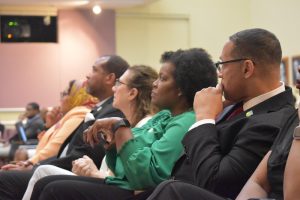Members of the Durham City-County Appearance Commission waited in a conference room on the ground level of City Hall on a recent February evening, ears attentive to the sound of footsteps. The committee meets on the third Wednesday of each month at 6 p.m — except the most recent “meeting” never began.
Four members were accompanied by the staff liaison, Kayla Seibel, as the clock crept to a quarter past 6. The bylaws specify that the majority of members, liaison excluded, must be present for the meeting to be valid. The group needed just one more member, hence the eyes and ears glued to the door.

McCreary looked across the room at me and a 9th Street Journal photographer and had a half-serious moment of inspiration. “Do either of you guys wanna be on the committee?” But then she realized, “We can’t even vote you in.”
Since a quorum was not present, the meeting was forced to operate as a “discussion.”
The goal of the City-County Appearance Commission is to “cultivate visual appeal and recognize the benefits of good design, which enhance quality of life.” The group accomplishes its mission of beautifying Bull City by promoting attractive landscaping and exemplary architecture (ambitious for a town lovingly referred to as “Dirty Durham”).
The meeting — sorry, discussion — began by clarifying the qualifications to be a commission member. Prior to 2017, the bylaws required three architects, three landscape architects, and two real estate agents, making it even more difficult for the group to fill the seats. This was revised to “all members of the Commission shall have a demonstrated interest… in community aesthetics, and a majority of the Commission shall have expertise in a design field.” Seibel loosened this further, removing the need to have expertise in a design field.
As long as Durham residents display an interest in the county’s good looks (or, apparently, happen to be a journalist in the conference room), they can serve. The modifications would help address the Appearance Commission’s problem with members failing to appear.
Seibel then asked for opinions on reducing the number of seats from 15 to nine. But discussion was interrupted by the sound of footsteps (Brandt Smith?!). Unfortunately, it was just a City Hall security officer. Discussion resumed.
Next up on the not-a-meeting agenda: the Golden Leaf Awards (new name pending). These awards, named after a tobacco leaf, lost traction once the pandemic hit. The purpose was for the appearance commission and the nonprofit organization Keep Durham Beautiful to collect nominations for properties that are “outstanding for (their) design, preservation, curb appeal, or stewardship of the natural and built environment.”
McCreary wanted a rebranding. “The idea is to start influencing the appearance of Durham through awards that are voted on by the people,” she said. The awards could recognize anything from citizens’ favorite bike paths and public spaces to outstanding architecture.
For a city (and a commission) in need of a facelift, members were excited about the awards and the community engagement they promised. Citizens would be involved first with a call for submissions and then with voting. McCreary suggested a tentative title for these accolades: the “Durham Nation Awards.” However, its implication that Durham itself is a country had her worried about whether officials would approve it.
The largest award would be decided by a panel of architects, to supplement the community’s voice with a professional opinion. “So it would be… two different ones. One legit award that’s like ‘Keep Durham Beautiful’ and then the people’s choice awards,” said McCreary.
In the past, they struggled to receive a lot of submissions. The new-and-improved awards might incentivize citizens to nominate architecture by entering them into a sweepstakes (“might” since no vote on the matter could be held). Conversation wrapped up soon after this, having exhausted the realm of “maybes” and “could-bes.”
Still no Brandt Smith. The discussion over, the next footsteps heard were the members walking out the door.
Photo at top: There were more chairs than members at the February Durham City-County Appearance Commission meeting. From left: Alva Horton, Kayla Seibel, Charles Simpson, and Imani McCreary. Photo by Abigail Bromberger – The 9th Street Journal



